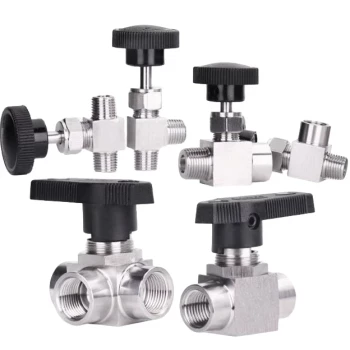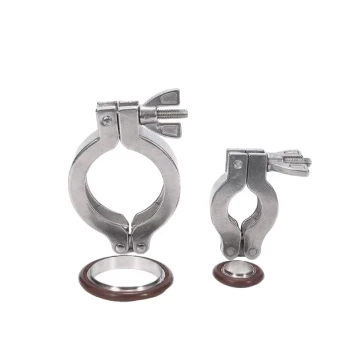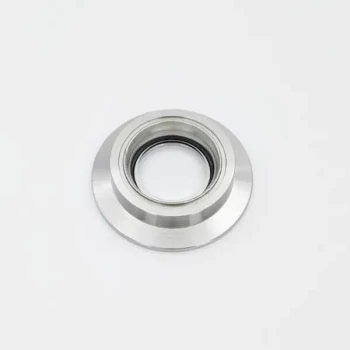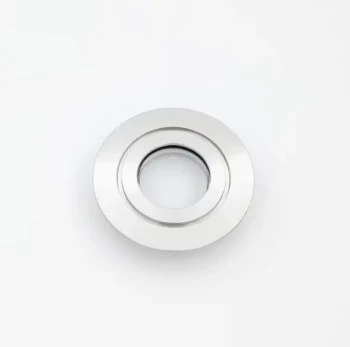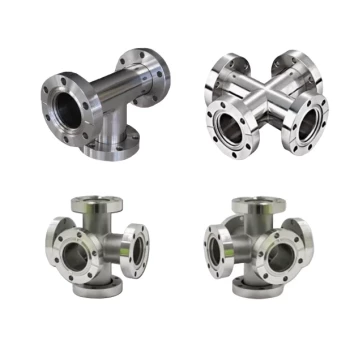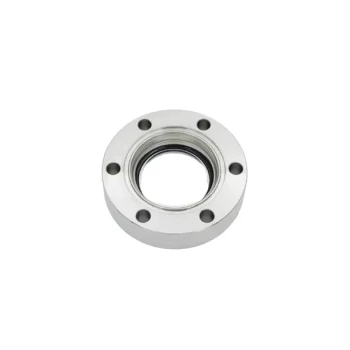The vacuum system described for this PECVD equipment is a two-stage configuration designed to achieve high vacuum. It is built around a high-speed turbomolecular pump for creating the process vacuum and a two-stage rotary vane pump for initial chamber roughing and to act as a backing pump. Key specifications for the turbomolecular pump include a 60 L/s pumping speed for nitrogen, a rotational speed of 69,000 rpm, and a maximum backing pressure of 800 Pa.
A PECVD vacuum system uses a "roughing" pump to quickly remove most of the air and a "high-vacuum" pump to reach the extremely low pressures needed for quality film deposition. The specifications reflect a delicate balance between pumping speed, ultimate pressure capability, and long-term operational reliability.
The Two-Stage Pumping Architecture
A PECVD process requires a vacuum environment that is both low-pressure and clean. A single pump cannot efficiently achieve this from atmospheric pressure.
This system uses a classic two-stage design: a "roughing" pump that works well at higher pressures and a "high-vacuum" pump that takes over at lower pressures to reach the final process conditions.
The Primary (High-Vacuum) Pump
The core of the system is a high-performance turbomolecular pump, which uses rapidly spinning blades to direct gas molecules out of the chamber.
Pumping Performance
The pump's effectiveness is defined by its speed and its ability to compress different gases.
- Pumping Speed: 60 L/s for Nitrogen (N₂). This drops slightly to 55 L/s when a protective net is installed over the inlet.
- Compression Ratio (N₂): 2 x 10⁷. This extremely high ratio indicates it is very efficient at removing nitrogen, the primary component of air.
- Compression Ratio (H₂): 3 x 10³. This lower value is typical for light gases like hydrogen, which are more difficult for molecular pumps to handle.
Mechanical & Operational Specs
These specifications detail the pump's physical operation and durability.
- Rotational Speed: 69,000 rpm. This high speed is what enables the pumping action.
- Bearings: Grease-lubricated ceramic bearings are used to withstand the high rotational speeds and minimize contamination.
- Bearing Lifespan: 20,000 hours. This is a critical metric for scheduling preventative maintenance.
- Start/Stop Times: Startup takes 1.5–2 minutes, while the coast-down stop time is 15–25 minutes due to the high rotational inertia.
System Integration
These specs define how the pump connects to the rest of the system.
- Inlet/Exhaust Ports: The pump has a KF40 suction port (inlet) and a G1 inch exhaust port.
- Maximum Back Pressure: 800 Pa. The turbomolecular pump requires a "backing" pressure below this threshold at its exhaust to function properly.
The Secondary (Backing) Pump
A secondary pump is required to create the low-pressure environment (below 800 Pa) that the primary turbomolecular pump needs at its exhaust.
The Role of the Rotary Vane Pump
This system uses a two-stage rotary vane pump. Its first job is to perform the initial "rough down," evacuating the chamber from atmospheric pressure. Its second, continuous job is to act as the backing pump for the turbomolecular pump.
Key Specification
The primary specification for this pump is its speed.
- Exhaust Speed: 160 L/min. This volume is sufficient to both rough the chamber in a reasonable time and maintain the required backing pressure for the primary pump.
Understanding the Trade-offs
The specifications are not just numbers; they represent engineering decisions with specific consequences for performance and maintenance.
Pumping Speed vs. Gas Type
A turbomolecular pump's efficiency is highly dependent on the mass of the gas molecules it is pumping. The massive difference between the compression ratios for nitrogen (2x10⁷) and hydrogen (3x10³) is a fundamental characteristic. This means that while the system is excellent at creating a nitrogen-free environment, processes involving large amounts of hydrogen will require careful management.
Performance vs. Protection
The pumping speed drops from 60 L/s to 55 L/s when a protective net is used. This represents a classic trade-off: the net protects the delicate, high-speed turbine blades from particulate damage, but it slightly impedes gas flow, reducing maximum performance. For most applications, the added reliability is worth the minor speed reduction.
Maintenance and Lifespan
The 20,000-hour bearing life is a finite number. Running the pump beyond this point significantly increases the risk of catastrophic failure, which can contaminate the entire vacuum chamber. This specification is the primary driver for a preventative maintenance schedule.
How These Specs Impact Your Process
Understanding these specifications allows you to predict system performance and plan your work accordingly.
- If your primary focus is throughput: The 160 L/min roughing speed and 60 L/s high-vacuum speed directly determine your chamber pump-down time, a key component of your total process cycle.
- If your primary focus is film quality: The high compression ratio for N₂ ensures a very low partial pressure of residual air, leading to purer films. The system's ability to achieve and hold a low base pressure is your most important metric.
- If your primary focus is operational reliability: The 20,000-hour bearing life is your key metric for planning maintenance and avoiding unscheduled downtime. The forced air cooling and robust controller are designed to protect this investment.
By translating these technical specifications into performance capabilities, you can better optimize your PECVD process for speed, quality, and reliability.
Summary Table:
| Component | Key Specification | Details |
|---|---|---|
| Turbomolecular Pump | Pumping Speed | 60 L/s for N₂ (55 L/s with net) |
| Turbomolecular Pump | Rotational Speed | 69,000 rpm |
| Turbomolecular Pump | Bearing Lifespan | 20,000 hours |
| Turbomolecular Pump | Max Back Pressure | 800 Pa |
| Rotary Vane Pump | Exhaust Speed | 160 L/min |
| System Architecture | Type | Two-stage pumping for high vacuum |
Enhance your PECVD processes with KINTEK's tailored solutions! Leveraging exceptional R&D and in-house manufacturing, we provide advanced high-temperature furnace systems like CVD/PECVD Systems, Muffle, Tube, Rotary, Vacuum & Atmosphere Furnaces. Our deep customization capabilities ensure precise alignment with your unique experimental needs, boosting efficiency and reliability. Contact us today to discuss how we can support your lab's goals!
Visual Guide

Related Products
- RF PECVD System Radio Frequency Plasma Enhanced Chemical Vapor Deposition
- Inclined Rotary Plasma Enhanced Chemical Deposition PECVD Tube Furnace Machine
- Inclined Rotary Plasma Enhanced Chemical Deposition PECVD Tube Furnace Machine
- Multi Heating Zones CVD Tube Furnace Machine for Chemical Vapor Deposition Equipment
- Cylindrical Resonator MPCVD Machine System for Lab Diamond Growth
People Also Ask
- How does plasma enhanced CVD work? Achieve Low-Temperature, High-Quality Thin Film Deposition
- How does plasma vapor deposition work? A Low-Temperature Solution for Advanced Coatings
- Is PECVD directional? Understanding Its Non-Line-of-Sight Advantage for Complex Coatings
- What is the second benefit of deposition within a discharge in PECVD? Enhance Film Quality with Ion Bombardment
- What role does PECVD play in optical coatings? Essential for Low-Temp, High-Precision Film Deposition








